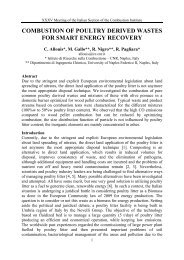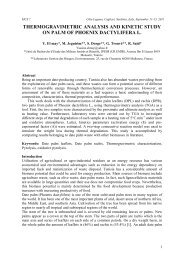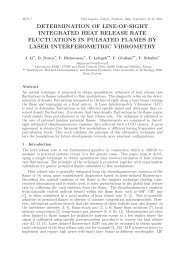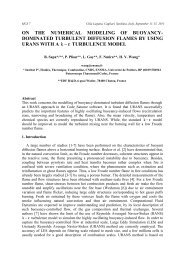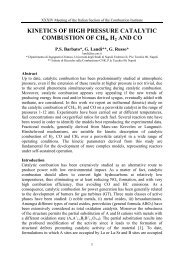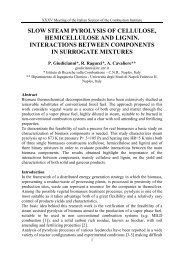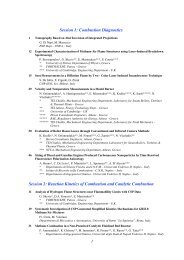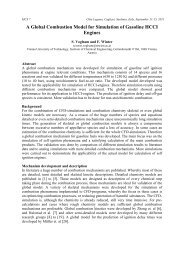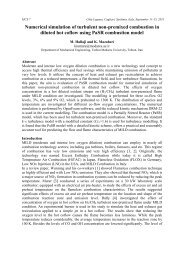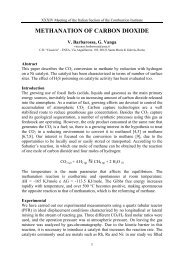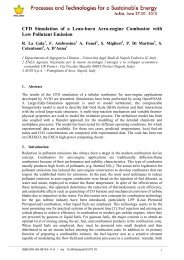Modelling of the heat transfer in a gas turbine liner combustor
Modelling of the heat transfer in a gas turbine liner combustor
Modelling of the heat transfer in a gas turbine liner combustor
Create successful ePaper yourself
Turn your PDF publications into a flip-book with our unique Google optimized e-Paper software.
The <strong>heat</strong> <strong>transfer</strong> coefficient calculated at <strong>the</strong> l<strong>in</strong>er <strong>in</strong>terface for <strong>the</strong> different cases<br />
highlights <strong>the</strong> importance <strong>of</strong> <strong>the</strong> distribution <strong>of</strong> <strong>the</strong> temperature <strong>in</strong>side <strong>the</strong> chamber. OP1, OP2<br />
and OP3 show a similar and proportional temperature distribution (Figure 7a) and <strong>the</strong>refore<br />
<strong>the</strong> calculated HTC is decreas<strong>in</strong>g proportionally to <strong>the</strong> load output <strong>of</strong> <strong>the</strong> <strong>combustor</strong>. Figure<br />
7b shows <strong>the</strong> effect <strong>of</strong> <strong>the</strong> Φ variation. For a higher value <strong>of</strong> <strong>the</strong> equivalence ratio, <strong>the</strong><br />
difference <strong>in</strong> temperature between <strong>the</strong> solid surface and surround<strong>in</strong>g fluid area <strong>in</strong>creases and<br />
<strong>the</strong>refore, <strong>the</strong> HTC decreases.<br />
The OP5 results show <strong>the</strong> effect <strong>of</strong> <strong>the</strong> elim<strong>in</strong>ation <strong>of</strong> <strong>the</strong> fuel <strong>in</strong> <strong>the</strong> quaternary l<strong>in</strong>e on <strong>the</strong><br />
<strong>the</strong>rmal behaviour <strong>of</strong> <strong>the</strong> <strong>combustor</strong>. The technique is useful for <strong>the</strong> stabilization <strong>of</strong> <strong>the</strong> flame<br />
never<strong>the</strong>less, clos<strong>in</strong>g <strong>the</strong> quaternary valve could be beneficial for <strong>the</strong> l<strong>in</strong>er walls because it<br />
lowers <strong>the</strong> temperatures at <strong>the</strong> l<strong>in</strong>er <strong>in</strong>terface as shown <strong>in</strong> <strong>the</strong> Figure 7(c).<br />
Figure 8 presents a zoom <strong>of</strong> <strong>the</strong> chamber-l<strong>in</strong>er-cas<strong>in</strong>g <strong>in</strong>terface. The temperature gradients<br />
generated by <strong>the</strong> fuel splits and by <strong>the</strong> turbulent flow as well as <strong>the</strong> cool<strong>in</strong>g effect on <strong>the</strong> outer<br />
l<strong>in</strong>er surface are visible. The compressor discharge air pass<strong>in</strong>g through <strong>the</strong> cavity walls cools<br />
<strong>the</strong> l<strong>in</strong>er and <strong>the</strong>refore <strong>the</strong> temperature <strong>of</strong> <strong>the</strong> discharge air <strong>in</strong>creases (see Table 4). Because <strong>of</strong><br />
<strong>the</strong> non-uniformity <strong>of</strong> <strong>the</strong> temperature gradients both <strong>in</strong> <strong>in</strong>tensity and direction, <strong>the</strong> material<br />
reacts with different <strong>the</strong>rmal expansion rates caus<strong>in</strong>g <strong>the</strong> bulg<strong>in</strong>g <strong>of</strong> <strong>the</strong> l<strong>in</strong>er and degradation<br />
<strong>of</strong> <strong>the</strong> material.<br />
Experimental data ga<strong>the</strong>red estimates <strong>the</strong> reduction <strong>of</strong> <strong>the</strong> temperature at <strong>the</strong> BM-TBC<br />
<strong>in</strong>terface. The results obta<strong>in</strong>ed by <strong>the</strong> CFD model <strong>in</strong>dicate a reduction <strong>of</strong> <strong>the</strong> temperature<br />
gradient through <strong>the</strong> l<strong>in</strong>er section to 309.4 K <strong>in</strong>stead <strong>of</strong> <strong>the</strong> 394.9 K calculated for <strong>the</strong> BM<br />
without TBC layer (OP1).<br />
Figure 8. Temperatures gradient zoom at <strong>the</strong> chamber-l<strong>in</strong>er-cas<strong>in</strong>g <strong>in</strong>terfaces.<br />
Conclusion<br />
The energy released by <strong>the</strong> combustion reaction process <strong>in</strong>side <strong>the</strong> combustion chamber is<br />
<strong>transfer</strong>red to <strong>the</strong> surround<strong>in</strong>gs caus<strong>in</strong>g temperature gradients and <strong>heat</strong> flux oscillations <strong>in</strong> <strong>the</strong><br />
l<strong>in</strong>er solid doma<strong>in</strong> that depletes <strong>the</strong> base material and coat<strong>in</strong>g and that damages <strong>the</strong> chamber<br />
walls. Degradation <strong>of</strong> <strong>the</strong> material properties, bulg<strong>in</strong>g <strong>of</strong> <strong>the</strong> chamber, crack development and<br />
release <strong>of</strong> damaged pieces downstream are some <strong>of</strong> <strong>the</strong> most common failures <strong>of</strong> <strong>the</strong><br />
combustion l<strong>in</strong>ers.<br />
Object <strong>of</strong> <strong>the</strong> study is to def<strong>in</strong>e <strong>the</strong> <strong>the</strong>rmo-pressure conditions and <strong>the</strong>ir dependency from<br />
<strong>the</strong> OP at <strong>the</strong> l<strong>in</strong>er wall surfaces (external and <strong>in</strong>ternal) for <strong>the</strong> development <strong>of</strong> an <strong>in</strong>tegrated<br />
fluid-structural model used for life time assessment <strong>of</strong> <strong>the</strong> <strong>combustor</strong> hardware.



